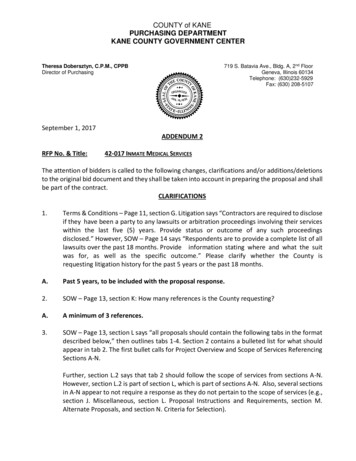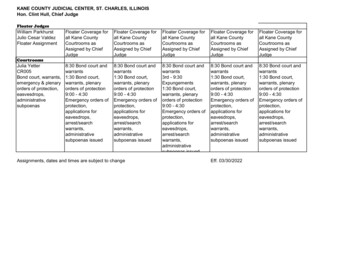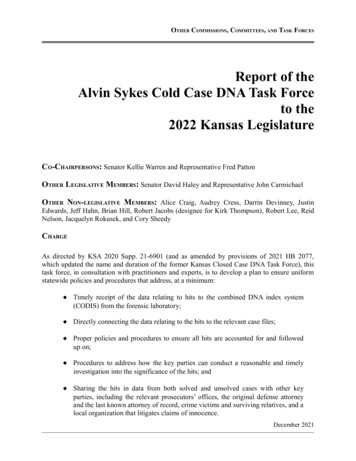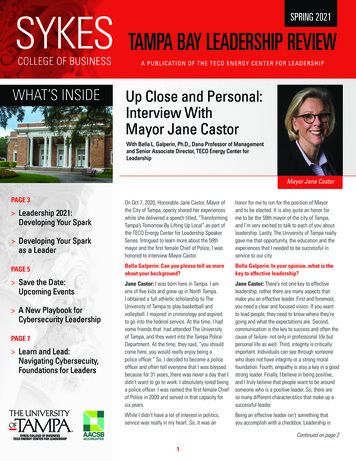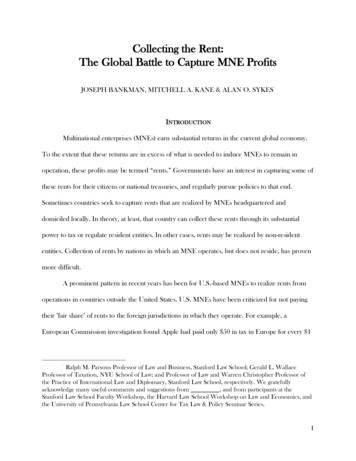
Transcription
Collecting the Rent:The Global Battle to Capture MNE ProfitsJOSEPH BANKMAN, MITCHELL A. KANE & ALAN O. SYKES*INTRODUCTIONMultinational enterprises (MNEs) earn substantial returns in the current global economy.To the extent that these returns are in excess of what is needed to induce MNEs to remain inoperation, these profits may be termed “rents.” Governments have an interest in capturing some ofthese rents for their citizens or national treasuries, and regularly pursue policies to that end.Sometimes countries seek to capture rents that are realized by MNEs headquartered anddomiciled locally. In theory, at least, that country can collect these rents through its substantialpower to tax or regulate resident entities. In other cases, rents may be realized by non-residententities. Collection of rents by nations in which an MNE operates, but does not reside, has provenmore difficult.A prominent pattern in recent years has been for U.S.-based MNEs to realize rents fromoperations in countries outside the United States. U.S. MNEs have been criticized for not payingtheir "fair share" of rents to the foreign jurisdictions in which they operate. For example, aEuropean Commission investigation found Apple had paid only 50 in tax in Europe for every 1*Ralph M. Parsons Professor of Law and Business, Stanford Law School; Gerald L. WallaceProfessor of Taxation, NYU School of Law; and Professor of Law and Warren Christopher Professor ofthe Practice of International Law and Diplomacy, Stanford Law School, respectively. We gratefullyacknowledge many useful comments and suggestions from , and from participants at theStanford Law School Faculty Workshop, the Harvard Law School Workshop on Law and Economics, andthe University of Pennsylvania Law School Center for Tax Law & Policy Seminar Series.1
million of profit, leading one commentator to describe Apple as "not only the world's largest for1profit corporation but also the world's largest tax-exempt one.” Similar complaints have beenmade about the lack of tax paid to foreign governments by companies such as Google and2Starbucks.Although U.S. firms may have garnered the lion’s share of the press in this context, this isby no means a phenomenon limited to U.S. companies. MNEs resident in other jurisdictions havelikewise been charged with adopting organizational structures and planning that purportedly strips3the tax base of local economies in illicit ways.1Edward Kleinbard, Apple’s Ireland Tax Avoidance Should Spur Major Reforms, The Hill (Sept.6, 2016), eforms.For example, in response to popular sentiment that Her Majesty's Revenue and Customs (HMRC)was not vigorously enforcing tax law against foreign headquartered companies, a committee of the House ofCommons took evidence from Starbucks, Google, and Amazon in proceedings that took place in 2012.Testimony showed Starbucks had captured a 31% market share but had reported losses in 14 out of 15years (and shown a modest profit in the other year), and that in 2011 Google had paid only 6 million taxon nearly 400 million revenue. See Vanessa Barford & Gerry Holt, Google, Amazon, Starbucks: The Riseof “Tax Shaming”, BBC News Mag. (May 21, 2013), http://www.bbc.com/news/magazine-20560359; seealso HMRC, Annual Report and Accounts 2011-12, Nineteenth Report of Session 2012-13, HC 716, at 13/cmselect/cmpubacc/716/716.pdf.The timing of these proceedings should be noted. The issue highlighted in these proceedings wascertainly limited neither to the UK nor to these particular companies. From 2012-2013, there was asignificant upswing in the attention paid to the profit levels of MNEs, especially from the perspective of thefailure of corporate income taxes to reach such profits. The United States Senate Permanent Subcommitteeon Investigations held an important hearing in 2013 that highlighted tax planning strategies of Apple.Offshore Profit Shifting and the United States Tax Code—Part 2 (Apple Inc.): Hearing Before PermanentSubcomm. on Investigations of S. Comm. Homeland Sec. and Governmental Affairs, 113th Cong. (2013).Also in 2013, the OECD published its initial action plan with respect to its still ongoing project regardingbase erosion and profit shifting (BEPS). OECD, Action Plan on Base Erosion and Profit Shifting (2013),http://www.oecd.org/ctp/BEPSActionPlan.pdf. The G20 then promptly endorsed the OECD BEPS actionplan. Saint Petersburg G20 Leaders’ Declaration (Sept. 5, 2013) (“We fully endorse the ambitious andcomprehensive Action Plan—originated in the OECD—aimed at addressing base erosion and profit shiftingwith mechanism to enrich the Plan as appropriate. We welcome the establishment of the G20/OECDBEPS project and we encourage all interested countries to participate”).See Nishith Desai & Mahesh Kumar, The Vodafone Saga – An Analysis of the Indian SupremeCourt’s Decision, 66 Bull. for Int’l Tax’n 366 (2012).232
National governments have begun to strike back. Sometimes this occurs in fora which4promote the virtues of multilateralism and coordination. Sometimes jurisdictions have begun toexperiment with unilateral measures that mark fairly radical departures from existing norms5governing tax and regulation. All such measures, however, strike us as ad hoc, in the sense thatthere exists no systematic attempt to analyze the benefits and detriments of the full range of policyinstruments that jurisdictions might apply in their attempt to reach MNE rents.This paper, by contrast, offers a comparative assessment of the policy instruments thatgovernments might employ to collect a share of rents from non-resident MNEs that operate withintheir borders. We begin with tax instruments, discuss recent attempts to expand those instruments,and then expand our analysis to antitrust policy, state-owned enterprises, price regulation, andvarious instruments of trade policy. Our goal is to identify the strengths and weaknesses of differentinstruments in different contexts. A related goal is to identify the circumstances in which we mightfind these instruments used.The comparative approach of this paper marks a departure from existing scholarship,which tends to discuss tax, trade, and other regulatory instruments in isolation. Some scholarshiphas explored the tax-trade intersection, but these articles examine issues of overlap or conflict. A6trade provision, for example, might preclude a particular kind of tax expenditure. Or, the45The prime example is the OECD BEPS project. See note 3.Prime examples are the diverted profits tax in the U.K. and the base erosion and anti-abuse tax inthe U.S.6That is the central story underlying the history of WTO/GATT disputes over provisions in theU.S. international tax law that potentially ran afoul of trade rules on subsidies. John H. Jackson, William J.Davey & Alan O. Sykes, Jr., International Economic Relations: Cases, Materials and Text on the Nationaland International Regulation of Transnational Economic Relations (West 6th ed. 2013). Morecontemporaneously, the EU has ruled that a member nation’s use of its tax administrative power hasviolated its commitment to open trade. Commission Decision No. 2014/C (ex 2014/NN) (ex 2014/CP)(State Aid to Apple), Aug. 30, 2016,http://ec.europa.eu/competition/state aid/cases/253200/253200 1851004 674 2.pdf.3
underlying policy goals of free trade may or may not undergird U.S. or international tax norms.7However, there do not appear to be any articles that provide a comparative analysis of the ways inwhich a nation might attempt to capture MNE rents through autonomous tax, trade, or regulatoryinstruments.A key aspect of our comparative analysis is that one must consider each potentialinstrument on its own terms, taking account of context. Different instruments are subject to distinctlegal constraints arising out of various treaty commitments and discrete aspects of publicinternational law. Some instruments may work to capture rents for certain sectors andorganizational forms, but not others. Despite this fine-grained aspect to the analysis, there is anorganizing theme. The ultimate ability of a jurisdiction to capture rents from foreign MNEs is afunction of the extent to which the jurisdiction has monopsonistic market power. Absent suchpower, no instrument will be effective. The interesting question is the relative merits of using oneinstrument or another where such power does exist.The Article is organized as follows. In Part I, we define terms, outline some relevantsources of MNE economic rent, and offer some simple theorizing about the objectives ofgovernments in the battle for rents and the international cooperation that may arise in response toit. Part II describes how jurisdictions may seek to capture economic rent through the tax system.Part III describes the role that non-tax instruments might play in capturing rent. Finally, Part IVattempts to draw general conclusions regarding the relationship among the various fieldsconsidered here.Paul R. McDaniel, Trade and Taxation, 26 Brook. J. Int'l L. 1621, 1622-25 (2001); Alvin C.Warren, Jr., Income Tax Discrimination Against International Commerce, 54 Tax L. Rev. 131, 132-34(2001).74
I. ECONOMIC BACKGROUND: RENTS, GOVERNMENT OBJECTIVES,GOVERNMENT LEVERAGE, AND THE ROLE OF INTERNATIONAL COOPERATIONThis Part begins with a discussion of the concept of “rent” and its important sub-categories.We then consider the incentives of governments to engage in efforts to capture different types ofrents, and certain limits on their capacity to succeed. Finally, we consider the externalities that arisewhen nations behave in this fashion and the possible incentives for international cooperation toaddress them.A. Conceptions of “Rent”In economics, a “rent” is a payment to a factor of production (labor, capital, land) in excess8of the amount required to induce that factor into the production process. A worker might bewilling to work for 10 an hour, for example, yet her wage might be 12 an hour, the excess beinga form of “rent.”One can further divide the set of payments that constitute “rents” into two categories:“quasi-rents” and “true economic rents.” A “quasi-rent” is a payment that fits the definition of rent,but that represents an ordinary return on investment, such as a competitive, risk-adjusted return tocapital investment. Quasi-rents arise because of irreversible investments of various sorts, such assunk capital investments in a factory, or in firm-specific human capital. An expectation of quasirents is essential if such investments are to be attractive to the investor.As an illustration, it is well known in microeconomics that a firm will continue to produceas long as the price received covers short run marginal costs. Revenues in excess of short run8For general background discussion of the various aspects of “rent” discussed in this Part, seeArmen A. Alchian, Rent, in 16 The New Palgrave Dictionary of Economics 115522 (3d ed. 2018).5
marginal costs are “rents,” therefore, but revenues up to the level of long run marginal costs (whichinclude an ordinary return on capital investment or “fixed costs”) are only quasi-rents. Likewise, ifrevenues fall below long run marginal costs, the firm will not replace capital assets and will contractor exit the market as its capital depreciates.Some rents, by contrast, are “true economic rents.” A landowner of scarce fertile land, forexample, may earn a return on agricultural activity that far exceeds what is necessary to keep theland in production and to provide a return on any improvements. These rents can coexist with acompetitive market. Consider a perfectly competitive industry with an upward-sloping long run9supply curve. An example might be an agricultural industry with land that ranges in quality, so thatas price rises more and more marginal land is put into production. The industry is competitive, inthe sense that price is equal to marginal cost in equilibrium for the marginal producers. Yet,producers on the lower end of the supply curve (“infra-marginal producers” with the mostproductive land in our agricultural example) nevertheless earn true economic rents because theequilibrium price is above their marginal costs of production. Holders of especially valuablehuman capital can realize similar rents.This paper focuses on rents realized by MNEs. The most obvious source of such rents isintellectual property, some of which qualifies for state-protected monopoly rights (copyright,patent, and trade-secret). But there are countless other sources of rents. MNEs may enjoyeconomies of scale that limit the number of viable competitors, conferring market power. Theymay realize rents in the form of reduced transactions costs as compared to wholly domestic entities9For a general overview discussion of perfectly competitive markets, see John Roberts, Perfectlyand Imperfectly Competitive Markets, in 15 The New Palgrave Dictionary of Economics 10196-97 (3d ed.2018).6
10that engage in cross border enterprise via contract with unrelated parties. They may realize rentsfrom (sometimes aggressive) tax planning in which the MNE’s organizational form permits tax11efficient location of assets and income across the various units of the MNE. This list is notexhaustive.The distinction between quasi-rents and true economic rents can be subtle, and depend onperspective. For example, an above-market return on one product might be necessary to offset12losses on another. A pharmaceutical company may realize surplus on many individualmedications but, due to losses on others and R&D investments that yield no payoff, realize only anordinary return on capital at the firm level on all invested capital. One could well say in such a casethat the firm has, in the aggregate, realized no true economic rent, and that apparent rents aresimply quasi-rents when viewed from the perspective of the firm’s operations as a whole.As discussed immediately below, the distinction between quasi-rents and true rents hasnormative implications for the consequences of governmental efforts to tax or otherwise capturethe rent. But as a positive matter, it will often be in the interest of nations hosting MNEs to collectpart of the rent, whatever its categorization. Accordingly, as the main emphasis of the paper is onthe positive question as to which instruments work best to extract rents, the challenge ofdistinguishing true rents from quasi-rents in practice has limited bearing on the discussion.10Richard E. Caves, Multinational Enterprise and Economic Analysis, 26 (1996) (surveying theliterature on the transaction cost approach).11 For example, if the firm can locate “winners” in a low-tax jurisdiction and “losers” in a high-taxone then it can reduce the tax cost of income inclusions and increase the value of deductions. Adroit useof tax planning tools can thus convert quasi-rents into true economic rents in some cases. This followsfrom the fact that the amount required to induce a factor into the production process must be assessed onan after-tax basis. Suppose a normal, risk-adjusted, after-tax return on a portfolio of assets (whichproduces some quasi-rents) is 5%. If a taxpayer is able to increase its after-tax return to something abovethis amount through tax planning that is not universally used across the market, then such surplusconstitutes rent.We use the term “surplus” here as a synonym for “rent.” In other words, the firm earns a surplusover the amount necessary to induce production.127
B. Government Objectives and the Capacity for Rent CaptureWe now turn to the objectives of governments and offer some thoughts about why, and towhat extent, governments will seek to extract MNE rents. For now, we put to the side the precisepolicy instruments for that purpose.Economic theory tells us that the extraction of true economic rents will not alter behavior13in the economy, as it will not drive resources to other pursuits. Taxation limited to true economicrents is thus “non-distortionary,” in contrast to most other forms of taxation that come with someefficiency losses that extend beyond merely the administrative costs of the tax system. In theinternational setting, one should contrast taxation of true economic rents from taxation on thenormal return on capital in particular. It is a well understood result from the literature on taxcompetition that a small, open economy seeking to impose a source-based tax on capital income14will simply drive capital away until after-tax returns to capital equalize. That loss of capital stockrepresents a distortionary cost to the national economy. A tax on true economic rents holds out the15possibility of avoiding that result.13As noted below, however, efforts to capture rents will fail absent the leverage that comes withnational market power.For the seminal paper on this issue, see Peter Diamond & James Mirrlees, OptimalTaxation and Public Production 1: Production Efficiency, 61 Am. Econ. Rev. 8 (1971); Peter Diamond &James Mirrlees, Optimal Taxation and Public Production II: Tax Rules, 61 Am. Econ. Rev. 261 (1971).Again, there must be national market power to capture rent. Market power will manifest in theterms a nation can achieve with respect to an MNE, but the power itself is a function of the nation’s positionas compared to other potential purchasers (i.e., host nations) in the market. Thus, it is also a wellunderstood result in the tax competition literature that if an MNE is choosing between two locations whichare mutually exclusive and each of which creates an opportunity to earn a rent, then it should choose theoption that generates the largest after-tax rent. Michael P. Devereux & Rachel Griffith, Taxes and theLocation of Production: Evidence from a Panel of U.S. Multinationals, 68 J. Pub. Econ. 335 (1998). Thismeans that a nation that attempts to tax the rent too harshly will drive the activity away. In the terms we usehere, the nation lacks market power in such an instance.14158
This is not to say that policies seeking to tax true economic rents present no efficiencyproblems. As noted, infra-marginal rents in competitive industries represent one category of trueeconomic rents. Because it is next to impossible to reach only infra-marginal producers withoutaffecting the margin, attempts to reach rents in this circumstance will come at a cost to efficiency.Consider, for example, a competitive exporting industry with an upward-sloping supply curve.Suppose that an importing nation imposes a tariff that is passed through to consumers and thusreduces demand. Exporters respond by moving down their supply curve. Marginal producers andsome relatively high-cost, infra-marginal producers drop out of production as price (net of tariff)falls below their marginal costs. The reduction in the price received by the remaining exportersimplies that they are absorbing part of the tariff and, in this sense, the jurisdiction is capturing trueeconomic rent. An efficiency loss still arises, however, because either supply will be curtailed orless-efficient domestic producers in the importing nation will pick up the slack, in either caseraising the costs to consumers in the importing nation unnecessarily.Similarly, when governments extract quasi-rents, they risk discouraging valuable economicactivity, perhaps driving it out of business altogether. For this reason, the short-term gains fromsuch policies may be outweighed by the long-term damage. To be sure, if governments can seizequasi-rents on a one-time, “surprise” basis, and credibly commit not to do so again in the future,the effects on economic activity may be negligible. But the ability to make such a crediblecommitment is questionable. An efficiency-minded government, therefore, might well steer clearof measures that significantly burden quasi-rents. Yet it would be naïve to imagine thatIn the sort of fact pattern we analyze in this paper, one could imagine, for example, that an MNEhas a fixed stock of goods to sell and is unable to ramp up production in the short term. Supposing that thesale of the good will generate true economic rents, but that the MNE can service only one of two nationaleconomies, one would predict that attempts to tax the rent by one nation would simply drive the MNE toservice the other.9
governments limit themselves to efficient policies. From a purely political standpoint, jurisdictionsmay often confront situations where foreign MNEs are perceived to be entering local markets andearning outsized profits without paying their “fair share.” Efforts to go after the returns to theseMNEs may be popular politically without much regard to their long-term economic impact.Moreover, even as to the governments that are concerned with “efficiency,” we must ask,“Whose efficiency?” It is commonplace in the literature on international trade policy to imagine,for example, that governments acting unilaterally pursue their national economic welfare ratherthan global economic welfare. This assumption seems entirely plausible. Foreigners generally do16not vote, do not provide campaign contributions to political officials, and so on. A focus onnational economic welfare changes the efficiency calculus importantly. Consider, for example, apolicy that extracts quasi-rents from producers in a multi-national industry, and funnels them to thenational treasury. Assume that this policy eventually causes the contraction of the industry and asizeable (and globally inefficient) rise in the price of its output. The benefits of that rent extractionpolicy nevertheless inure to the country that undertakes it. The costs, by contrast, fall on all theconsumers globally who must pay higher prices in the long run. The situation thus presents aclassic externality problem. Governments may well engage in such behavior despite the loss inglobal welfare, and, of course, when many countries engage in such policies simultaneously, theproblem is compounded.Lastly, we should underscore an important general point relating to the capacity of nationsto capture either true economic or quasi-rents from foreign firms. National market power isessential to a nation’s capacity to capture these rents. In its absence, firms would respond to efforts16See, e.g., Kyle Bagwell & Robert W. Staiger, The Economics of the World Trading System(2002).10
at rent extraction by, for example, passing along all the costs associated with rent extraction effortsto consumers (as by refusing to lower price in the face of a new tariff), or by withdrawing from thejurisdiction of the nation seeking to extract rents (as by exiting the market of a taxing authority).Only if firms cannot replace lost business opportunities in the nation that seeks to capture theirrents with equally good opportunities elsewhere will the nation have any leverage to extract rents.As an example, suppose that an importing nation deals with competitive suppliersexhibiting an upward-sloping supply curve for some products or services that it purchases fromabroad. That nation is not a “price-taker” in the relevant international markets. Collectively, itsconsumers have the power to influence the price that they pay and, in that sense, have a degree ofcollective monopsony power that the national government can exploit to extract rents.C. The Role of International CooperationThe preceding Section immediately suggests a role for international cooperation to reducethe inefficiencies that would arise if nations, acting unilaterally, engage in policies that produceglobal welfare losses, such as policies that extract foreign quasi-rents and infra-marginal rents incompetitive industries. Existing international cooperative arrangements in various areas may beinterpreted as serving that function.Trade treaties, for example, are often framed as mechanisms for enhancing “marketaccess” for firms seeking to do business abroad. The impetus for improved market access,however, comes from exporting industries that lose rents from protectionist trade policies abroad.In particular, the modern “terms of trade” theory of trade agreements has been prominentlydeveloped using models of competitive industries with upward-sloping supply curves engaged ininternational trade. The terms of trade externality in such models, which serves as the basis for11
international cooperation to eliminate it, comes precisely from the damage that protectionism doesto the infra-marginal rents earned by foreign exporters.17Accordingly, in many of the policy areas that we examine in this paper, international lawarises to impose some constraint on the ability of nations to engage in rent extraction policies thatwould result from the pursuit of unilateral self-interest. The analysis below will touch on many ofthose constraints. As shall be seen, however, these constraints are often limited, crude, andimperfect, and are far more developed in some policy areas than in others.Moreover, although theory suggests that nations will tend to cooperate to avoid the mostserious global inefficiencies that might otherwise arise, the pursuit of efficiency is not the only issuein play. Even if international cooperation could achieve the efficiency frontier perfectly, it wouldremain to determine who captures the surplus from getting to the frontier. Some of the policiesthat we discuss below can be understood as part of the battle over the division of surplus.II. TAX APPROACHES TO CAPTURING RENTGovernments have multiple tax policy options in their quest for MNE rent capture. Eachoption has its own pitfalls and efficacy profile. Additionally, MNEs have expected responses to thevarious policy moves. We consider three tax policy approaches here.A. Source-Based Income Tax with Separate Entity Accounting and Arm’s Length Standard17Harry G. Johnson, Optimum Tariffs and Retaliation, 21 Rev. of Econ. Stud. 142 (1953); Bagwell& Staiger, note 18.12
A source-based income tax with separate entity accounting is a, if not the, dominant18method through which jurisdictions tax the profits of foreign MNEs. MNE taxation is generallydebated against the backdrop of this tax, and we introduce three stylized examples of MNEorganization to illustrate the efficacy of a source-based income tax to claim MNE rents in differentcontexts. Later, we will return to those examples to illustrate the efficacy of other approaches toclaiming such rents. Our examples should not be read to describe the organizational structure ofany specific MNE, though we have clearly been influenced in our choices by some of the moreprominent U.S. MNEs. There have been many articles written describing the intricacies of variousstructures and offering assessments of their soundness. Our focus is different. Our key observationthroughout this project is that a host jurisdiction’s ability to capture rent depends on its marketpower; that is, on its ability to exercise leverage because its economy as a whole is in the position of18We define relevant terms here briefly for readers less familiar with international tax principles:A “source-based income tax” is one in which a nation establishes the jurisdictional prerequisites forimposing tax on an income base in virtue of some connection between the income sought to be taxed andthe geographical territory of the sovereign. This is to be distinguished from a “residence-based tax,” whichestablishes jurisdictional prerequisites in virtue of some connection between attributes of the taxpayer andthe sovereign. For firms, residence-based tax will typically be premised either on place of incorporation,place of management, or place of central operations. If an MNE lacks residence under the applicablecriterion, then it is a “foreign MNE” for these purposes, and an income tax obligation can only arise under asource theory. This is why source-based income tax is central to our analysis of tax instruments. For furtherbackground on source-based taxation, its conceptual underpinnings, and its limits, see Mitchell A. Kane, ADefense of Source Rules in International Taxation, 32 Yale J. on Reg. 311 (2015).By “separate entity accounting” we refer to the concept that the legal personhood of distinct legalentities is respected for purposes of calculating tax base even if those entities are commonly controlled. Forexample, a royalty paid to the parent of a foreign MNE by a wholly-owned local subsidiary will have taxeffect. Thus, it may give rise to a deduction in the host country, implicate withholding taxes on outflowingroyalties in the host country, and give rise to inclusions with respect to the recipient. Because credence ispaid to such payments, their nominal amount is important. The “arm’s length standard” requires broadlythat such amounts, or transfer prices, be determined in accord with what would have been paid at arm’slength as between unrelated parties. For a broad overview of arm’s length transfer pricing, see JensWittendorf, Transfer Pricing and the Arm’s Length Principle in International Tax Law (2010). For adiscussion of the limits and complications of the arm’s length principle as applied to the issue of economicrents arising within MNEs specifically, see Mitchell A. Kane, Transfer Pricing, Integration, and SynergyIntangibles: A Consensus Approach to the Arm’s Length Standard, 6 World Tax J. 2812 (2014).13
a monopsony. The point of working through three stylized examples, rather than a single genericMNE, is to highlight the difficulty, under current law, of taxing companies that engage in a range ofcross-border activity, and to show how changes in the tax law might differentially affect companieswith different forms of business organization.Consider, first, a U.S.-headquartered company, Computer, that has developed most of itsIP in the U.S., and then licensed that IP to a subsidiary in a low-tax jurisdiction elsewhere (or19achieved partial o
JOSEPH BANKMAN, MITCHELL A. KANE & ALAN O. SYKES* INTRODUCTION Multinational enterprises (MNEs) earn substantial returns in the current global economy. . * Ralph M. Parsons Professor of Law and Business, Stanford Law School; Gerald L. Wallace Professor of Taxation, NYU School of Law; and Professor of Law and Warren Christopher Professor of .





